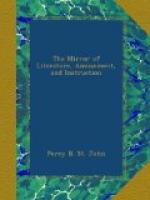Now, respecting the origin of this custom, I merely, by way of hint, submit, that in the time of Christian martyrdom, as tar barrels were used for the “burning at the stake” to increase the ravages of the flame:—the custom is derived,—out of rejoicings for the abolition of the horrid practice, and this they show by carrying them on their heads (as represented at page 296, vol. 8.), but you may treat this suggestion as you please, and perhaps have the kindness to substitute your own, or inquire into it.
W.H.H.
[14] See MIRROR, vol. 8, page 296.
* * * * *
CUSTOM OF BAKING SOUR CAKES.
(For The Mirror.)
Rutherglen, in the county of Lanarkshire, has long been famous for the singular custom of baking what are called sour cakes. About eight or ten days before St. Luke’s fair (for they are baked at no other time in the year), a certain quantity of oatmeal is made into dough with warm water, and laid up in a vessel to ferment. Being brought to a proper degree of fermentation and consistency, it is rolled up into balls proportionable to the intended largeness of the cakes. With the dough is commonly mixed a small quantity of sugar, and a little aniseed or cinnamon. The baking is executed by women only; and they seldom begin their work till after sunset, and a night or two before the fair. A large space of the house, chosen for the purpose, is marked out by a line drawn upon it. The area within is considered as consecrated ground, and is not, by any of the bystanders, to be touched with impunity. The transgression incurs a small fine, which is always laid out in drink for the use of the company. This hallowed spot, is occupied by six or eight women, all of whom, except the toaster, seat themselves on the ground, in a circular form, having their feet turned towards the fire. Each of them is provided with a bakeboard about two feet square, which they hold on their knees. The woman who toasts the cakes, which is done on an iron plate suspended over the fire, is called the queen, or bride, and the rest are called her maidens. These are distinguished from one another by names given them for the occasion. She who sits next the fire, towards the east, is called the todler; her companion on the left hand is called the trodler;[15] and the rest have arbitrary names given them by the bride, as Mrs. Baker, best and worst maids, &c. The operation is begun by the todler, who takes a ball of the dough, forms it into a cake, and then casts it on the bakeboard of the trodler, who beats it out a little thinner. This being done, she, in her turn, throws it on the board of her neighbour; and thus it goes round, from east to west, in the direction of the course of the sun, until it comes to the toaster, by which time it is as thin and smooth as a sheet of paper. The first cake that is cast on the girdle is usually named as a gift




